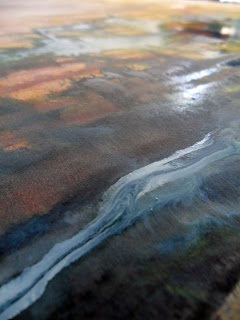I am now viewing paint as the subject matter, with formalist views in mind, I have chosen to produce a triptych of the primary colours as this is the basis of colour. I wish to produce layers of paint to make the surface thicker. This makes the audience understand paint as a physical substance instead of treating it as a material available for manipulation. I wanted to document the change as I will change the layers over a series of days. I also took close-up photographs to observe the interaction of colours, and the interaction of paint on canvas. All the photos I collect I wish to make part of my finished piece as they not only closely examine the qualities of paint and mark making, but as they visually define the term abstract; due to the emphasis on the formal elements, colour and line.
When taking the photographs, the red and yellow canvas produced more appealing images, but I was finding it difficult to produce as strong an image from the blue canvas. After examining the canvas' together I observed that the blue canvas had less textural marks, but more areas where turpentine has washed down the inks. Photographing theses surface interactions made less interesting photographs, therefore through the next layers I want to make thicker interactions of colour.

I also worked on the combination of film stills again (although I started it before I decided to stop producing work from the stills, it needed finishing). The painting went through numerous layers and areas of definition. I realised that it was not working well due to the various layers of vivid tonalities fighting against one another. I kept my sketchbook open next to me as I work, therefore I could observe all the stills and extract particular areas of information to translate to the canvas. Understanding that I had no acquired a confused blend of tones, I took inspirations from the stills to makes larger areas of tone. I purposely selected to use a roller as it applies a more evenly spread tone and made less areas of confusion. Taking away the fingerprint has made the image clearer and more refined, as the image as a whole has more focus and balance. Through producing numerous layers, it has given way to another opportunity to obtain photographs of paint interactions. This series of photographs explore the way layers react to paint. I am planning to organise my collection of photographs according to what paint qualities they depict, texture, layers, vivid colour or mark-making.







The photograph on the left heavily reminds me of the work of Jackson Pollock, where the sand creates raised marks the roller has picked up these areas first. On this scale they take the appearance of gravitational drips like Pollock, I find it interesting how they have been made in different ways but take a similar appearance.
'I have no fears about making changes, destroying the image, etc., because the painting has a life of its own. I try to let it come through.' Pollock.[p.347]
Gualdoni.F (2008). ART The Twentieth Century. Skira. ISBN: 978-88-6130-801-5
As the photograph reminded me of Pollock I decided to further my knowledge of him and finding this quote, it changed my thoughts on my painting as I was becoming frustrated with the outcome due to the series of changes. Although I like the close up photos I don't feel comfortable with the painting itself. However taking on board what I have read, and thinking about the life of the painting by stopping where I have, it reflects a relationship with the image; I have consciously reflected on the development of the painting throughout, and progressed depending on what is suitable for the painting.
After being inspired by Tapies and introducing sand to the canvas my aim was to generate earthly surfaces, which I achieved in the rougher surface and layers of paint. However, unexpectedly other earthly aspects have presented themselves; through areas of void where previous layers of paint show through, I feel some of the photos resemble satellite images of the earth or in contrast, microscopic organisms.





















































